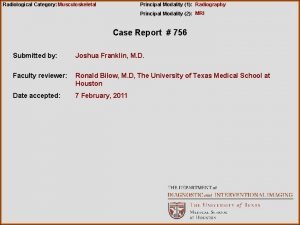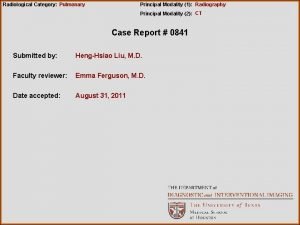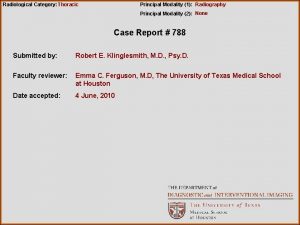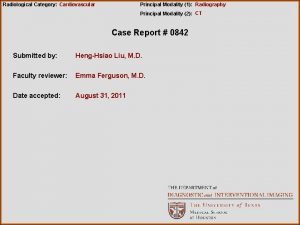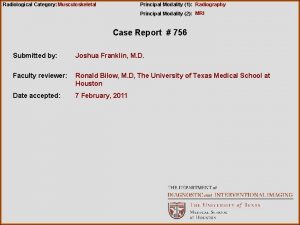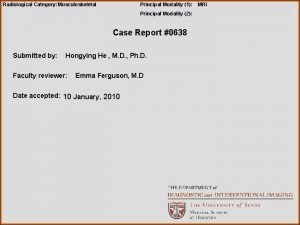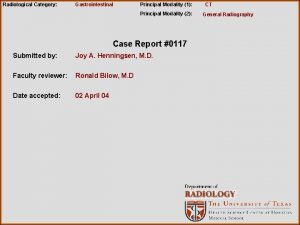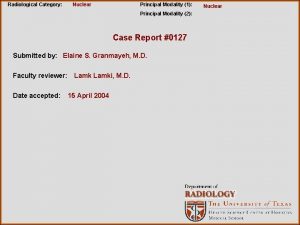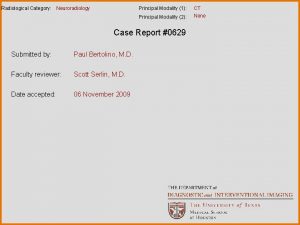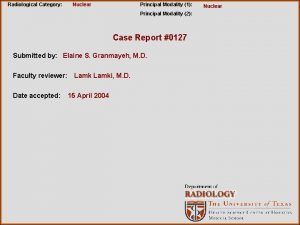Radiological Category PediatricsMSK Principal Modality 1 Radiography Principal













- Slides: 13

Radiological Category: Pediatrics/MSK Principal Modality (1): Radiography Principal Modality (2): CT/MRI Case Report # 0941 Submitted by: Craig E Cook, M. D. Faculty reviewer: Larry Robinson, M. D. Date accepted: Erase this and enter date accepted in format of: day month year Example: 01 January 2002

Case History 6 -year-old female with right knee pain, swelling and a limp.

Radiological Presentations

Radiological Presentations

Radiological Presentations

Test Your Diagnosis Which one of the following is your choice for the appropriate diagnosis? After your selection, go to next page. • Giant Cell Tumor • Chondroblastoma • Osteomyelitis with abscess • Metastases (Leukemia, Neuroblastoma, Lymphoma)

Findings and Differentials Findings: Radiographs – ill-defined lucent lesion centered in the proximal tibial metaphysis with lucency crossing the physis and involving the epiphysis up to the articular surface CT – lucent lesion in proximal tibial metaphysis crossing the physis into the epiphysis – small calcification seen within the lesion MRI – STIR hyperintense lesion within the medullary cavity with surrounding soft tissue edema – T 1 fat-sat post-contrast demonstrates rim enchancement with central fluid intensity/necrosis; enhancement of the surrounding soft tissues Differentials: • Osteomyelitis – Brodie Abscess • Giant Cell Tumor • Chrondroblastoma • Metastases

Discussion The most common cause of pediatric osteomyelitis is hematogenous spread, less commonly a result of contiguous infection or direct implantation. The most common pathogens are S. aureus (43%), beta-hemolytic streptococcus (10%) and S. pneumoniae (10%). Hematogenous spread usually results in seeding to a long bone metaphysis (femur>tibia>humerus>fibula) about 70% of the time. Other less common sites of spread include short bones (6%) and the spine (2%). Brodie abscess is a complication typically of subacute osteomyelitis. It is a result of infection within the medullary canal that leads to liquefaction and increased intraosseous pressure. A sequestrum may also be present, which is a piece of devitalized bone that has become separated during the process of necrosis Osteomyelitis is often radiographically occult or subtle, especially in the early phase of disease, because bony destruction and periosteal reaction don’t typically occur until 7 -14 days after onset. CT findings of osteomyelitis include bony destruction and surrounding sclerosis with adjacent soft tissue edema. On MRI, one would see marrow edema with surrounding post-contrast enhancement. An abscess cavity will demonstrate central hypointensity with a well-defined thick rim of enhancement.

Discussion Giant cell tumor is a classically benign (5% malignant) bone tumor that originates in the metaphysis and extends into the epiphysis, commonly to the subarticular bone. This tumor represents 4 -5% of all primary bone tumors and ~20% of all benign primary bone tumors. The most common sites of involvement are distal femur > proximal tibia > distal radius. The lesion is an eccentric purely lytic geographic lesion with the unique characteristic of a narrow transition zone and no sclerotic margin. Periosteal reaction is usually not present. About 30 -50% of lesions will demonstrate cortical breakthrough with an adjacent soft tissue mass. The peak age range is 20 -50 years, rarely occurring in skeletally immature patients. The MRI appearance is somewhat nonspecific, demonstrating heterogeneously low T 1 signal, heterogeneously high T 2 signal and heterogeneous enhancement. CT is helpful for nothing more that determining the degree of cortical thickening or subtle areas of cortical breakthrough, which can guide management.

Discussion Chondroblastoma is a benign cartilage tumor arising from the epiphysis of skeletally immature patients and frequently extending into the metaphysis. Greater than 75% will occur in long bones including proximal humerus > proximal tibia > proximal and distal femur. The tumor is an eccentrically located lytic lesion with about half having a chondroid matrix and the majority having a thin sclerotic rim. Larger, more long-standing lesions may demonstrate periosteal reaction, but smaller lesions typically lack any reactive periosteum. There may be mild cortical thinning or expansion, but almost never cortical breakthrough. The peak age range is 10 -25 years with a nearly 2: 1 male predominance. The MR appearance is heterogeneously low T 1 signal, heterogeneously high T 2 signal and mild heterogeneous post-contrast enhancement. The CT appearance mirrors the radiographic appearance with better visualization of the chondroid matrix.

Discussion Bony metastases in the pediatric population occur most commonly in the setting of neuroblastoma. Other less common sources are leukemia and rarely lymphoma. Neuroblastoma is a malignant tumor of primitive neural crest cells, which is the third most common pediatric malignancy and the most common extracranial solid malignancy in children. It is less common in children over 3 years, but lytic, sclerotic or mixed metastases may be the presenting finding in older children. Virtually any form of leukemia may have osseous findings, but it is typically manifested as “leukemic lines” (radiolucent transverse metaphyseal bands) or a moth-eaten lytic appearance, very rarely solitary.

Diagnosis Osteomyelitis with Brodie abscess

References Donnelly, LF. Musculoskeletal. In: Pediatric Imaging: The Fundamentals. 1 st edition. Philadelphia, PA: Saunders Elsevier, 2009. Manaster BJ, May DA, Disler DG, eds. Introduction to Bone Tumor Imaging, Musculoskeletal Infection and Cartilage-Forming Tumors. In: Musculoskeletal Imaging: The Requisites. 3 rd edition. Philadelphia, PA: Mosby Elsevier, 2007. Stat. Dx
 Erate pa
Erate pa National radiological emergency preparedness conference
National radiological emergency preparedness conference Radiological dispersal device
Radiological dispersal device Tennessee division of radiological health
Tennessee division of radiological health Center for devices and radiological health
Center for devices and radiological health Modality in software engineering
Modality in software engineering Sensory modality examples
Sensory modality examples Epistemic modality
Epistemic modality Lexical vs auxiliary verbs
Lexical vs auxiliary verbs Skill focus: persuasion
Skill focus: persuasion Cardinality and modality
Cardinality and modality Diplode
Diplode Modality microsoft services
Modality microsoft services Epistemic modality
Epistemic modality














